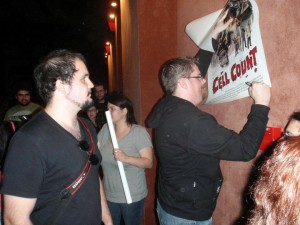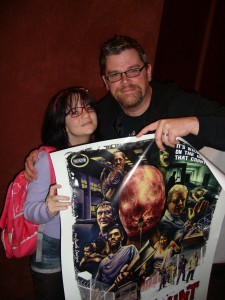Translated Article from magazine “Ecran Fantastique” in France.
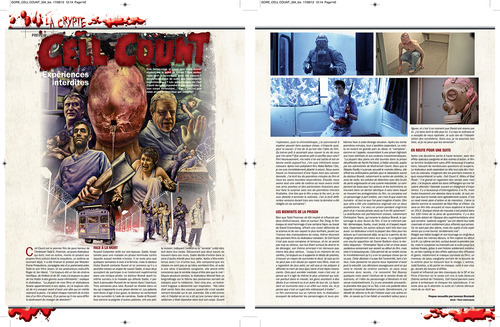
CELL COUNT - di Lorenzo Ricciardi
What would you do if your loved ones were going to die? What would you do to save their lives? Would you be willing to undergo experimental treatments? The protagonists of Cell Count will find it out despite themselves… It’s what’s on the inside that counts.
Cell Count is the first pure horror movie directed by the american Todd E. Freeman, a young director who writes, directs, photographes, edits and produces his movies (this is his fifth one and at the moment he’s filming a new one). The movie has been financed and produced by Wooden Frame Productions, a partnership between Todd and his brother Jason and the executive producers Roger and Jen Wood, utilizing the Indigenous Oregon Production Investment Fund: “I’ve always been a fan of horror, thriller, and sci-fi movies but I have always been afraid to tackle such an intimidating genre. Most of my favorite movies and filmmakers are in these genres and I never wanted to jump into it unless I had the right idea. I absolutely loved every facet of making a horror movie. It’s going to be hard to want to make any other type of movie ever again”, the director said.
Plot: Russell Carpenter attends to his wife, Sadie in hospital where she is terminally ill with a fatal disease that the state hospitals cannot cure. With Sadie only having weeks to live, Doctor Victor Brandt approaches Russell and offers Sadie a chance at surviving if both she and Russell embark on his experimental cure at a private clinic. Doctor Brandt having survived the same disease himself persuades Russell as he agrees to sign up for the programme. Three weeks later Russell wakes up in the facility which is built like a high tech prison. The patients are free to do as they please whilst the doctor watches their every move via the security cameras. Sadie and Russell, along with the a handful of other patients have small incisions where the ‘cure’ has been inserted into their body. Finding out that two murderers are also locked up in the facility with them, Sadie decides to enter the restricted zone to speak with them. Only after talking to one of the murderer’s does Sadie learn that all is not what it appears and after a series of gruesome incidents, she finally realises that the cure could be worse than the disease itself.
For years before actually setting out to shoot it, the director wanted to make a movie about people being test subjects for medical experimentation. Then five years ago the tragic event that sparked all: “My mother was out shopping when suddenly she passed out and fell to the ground. She was taken to the hospital and was immediately told that she had a tumor exploded in her abdomen which spread the disease throughout her body. Through the operation and subsequent chemotherapy I began wishing that I could do something, anything, to save her. That’s where the idea was born. What would you do to save the one you love? Who and what would you sacrifice to take their pain away? On a very important note: my mom is alive and well. She’s been cancer free for years and for that I am most thankful”, Todd Freeman said, “After my last movie, Wake before I die, I immediately started to work on this one. We got financing in a very unconventional way. I wrote the first 10 minutes of the movie and we shot it on our own. We then rented out a theater and took our dear friends and business partners and surprised them with the completed first 10 minutes of the movie. Once the movie had the green light I then went to finish the screenplay. I would say I wrote different drafts of the movie over 3 years but the final draft was put together in about a 6-week period”.
Despite Todd Freeman has been inspired and influenced by two masterpieces, Alien and especially Carpenter’s The Thing, the movie recalls and homages somehow David Cronenberg, giving a twisted vision of science and its terrifying side, a sense of body horror, evident peculiarity of early Cronenberg. Though Cell Count is not so intricated and twisted and it doesn’t take itself too seriously, its purpose is to entertain, a fun movie that makes you squirm in your seat. But the theme he wanted to focus his attention on is quite serious: “Until this point in my career I have been coping with death and dealing with how to move on and stay strong after loved ones die. I know you could never guess that looking at my filmography, but it’s very much apparent that subconsciously I am trying to prepare myself for the death of everyone I love. It sounds very morbid, but it’s true. I think it is the most universal of all themes because everyone all over the world deals with this at some point in their life. How we deal with death ultimately determines how we live our life and I think that’s a very interesting subject”, Todd Freeman said.
The movie starts slow, the director tries to introduce the charaters and shows the difficulties they face in that strange situation. Just after 30 minutes it starts to put into gear. Much of the merit goes to the location, ‘the facility’, as it is called, not unlike an aseptic prison, techonologically advanced, with sterilized walls and monochromatic colors: “Most of the film was shot in the empty minimum-security correctional facility in North Portland, paid for by the taxpayers of Multnomah County. While the Wapato Facility has never housed a single inmate, it provided a plethora of amazing backdrops for all of the areas of Dr. Brandt’s secret research lab, including the control room, a space-age visitation room, holding cells with spooky door slots, and an industrial kitchen”, the director said, “Base camp for cast/crew was in a dormitory identical to the one where the film’s subjects are housed. The facility is as much of a character in the story as the humans (and whatever else) that inhabit it. For the duration of the shoot, I slept in an RV locked into the facility’s processing yard. To say that it was a strange experience would be a vast understatement. I lived in prison for 23 days and I wouldn’t have had it any other way”.
The cast is very good, especially Christopher Toyne who plays Dr. Brandt, the best character in the movie. He is a perfect villain: evil, cunning, diabolical, raw, with a frightening look. But most of the cast did a good work. The director wrote most of the roles for these specific actors because he already knew them as people and imagined how they would throw themselves into the roles. There is also a little cameo of Daniel Baldwin in the final sequence: “Christopher Toyne made a very bold decision with an accent early on and I loved it. It immediately made you aware that something was wrong with this guy. Some people hate the decision and others love it. But no one can ever accuse us of playing it safe. Bold decisions are what makes the world of film exciting and we decided to go for it. I met Ted Rooney a couple months before I wrote the final draft and I immediately came up with the idea of Abraham. Funny story: the first thing I saw Ted in was a Mountain Dew commercial where he played Abraham Lincoln. Lastly I decided to rewrite the ending with a sequel in mind. I knew I needed a great actor to come in at the end and get people excited about seeing a road movie sequel. Daniel moved to the NW earlier that year and I wrote the role specifically for him. He got the script and immediately came on board. I am so happy with all of the performances and actors in the film. Without them I’m afraid I’d be nothing, so I’m thankful”, Todd Freeman said.
After an adrenalinic second part, with bloody special effects and action scenes, the movie ends suddenly without many explanations and with questions still unanswered. But the director, during the writing, already had in mind a sequel, ‘Cell Count II: 100 Miles of Bad Road’: “I was raised watching serials with my dad. I always loved a good cliffhanger that made me so excited for the next episode. There are many unanswered questions that will absolutely be answered in the sequel. I think everyone will be pleasantly surprised. It’s an action packed monster road movie. I like to explain it as Road Warrior meets Aliens. It will be a fun ride. We hope to shoot it in 2013”, the director said, “Something bad happened in the surrounding 100 miles of quarantined land. There are mutants from the years of medical experiments as well as many of the “cures” that have grown to full size and are seemingly more hungry than ever. Not really alien, but experiments gone wrong, horribly wrong”.
Despite the low-budget and a 22-day shooting schedule inside the same big location, the movie, from beginning to end, captures the audience’s attention. The pace is slow, especially in the first part, but the suspence increases progressively until the final sequences, thanks a solid story, good cast and amazing special effects, very effective and gore, in particular the face mask (the symbol of the movie, shown in front of the poster), a bloody tissue leaked from the mouth of the victim that enclosed completely his head. The actor, Judd Eustice, had to have that mask attached to his face and wrapped tightly around his head for upwards of 10 hours a day. Inspired and influenced by the best sci-fi movies like Alien and The Thing and the body horror genre (the terrifying central theme), practically created by the early works of David Cronenberg, Cell Count is successful in involving and upsetting the viewer. Waiting to see the sequel and the very final end of the movie…

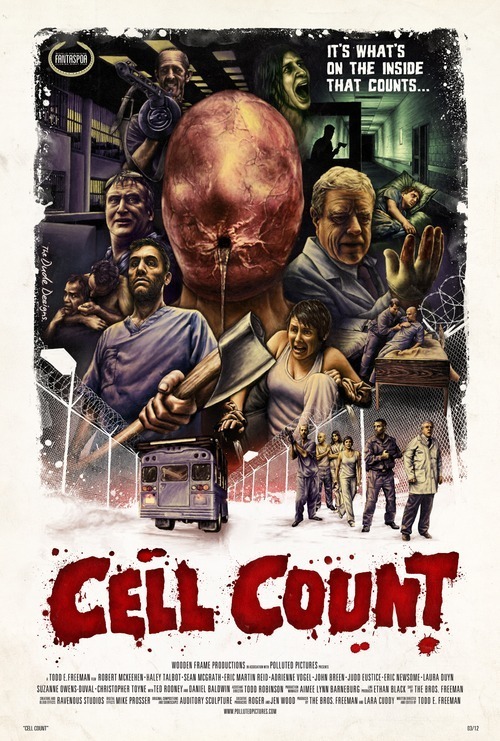
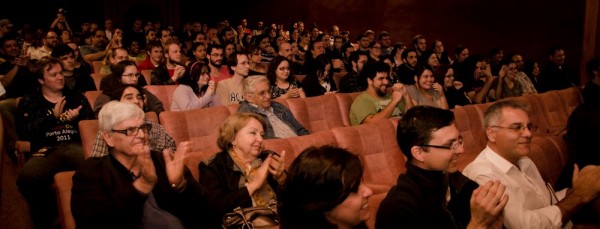
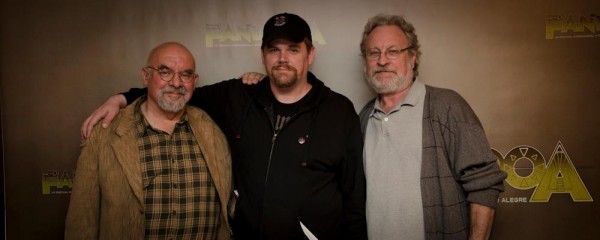
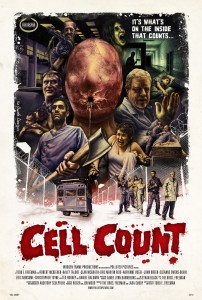 MORE HORROR REVIEW (USA)
MORE HORROR REVIEW (USA)